Iron-Based Metal-Organic Frameworks as Multiple Cascade Synergistic Therapeutic Effect Nano-Drug Delivery Systems for Effective Tumor Elimination
- PMID: 38931479
- PMCID: PMC11206809
- DOI: 10.3390/ph17060812
Iron-Based Metal-Organic Frameworks as Multiple Cascade Synergistic Therapeutic Effect Nano-Drug Delivery Systems for Effective Tumor Elimination
Abstract
Efforts have been made to improve the therapeutic efficiency of tumor treatments, and metal-organic frameworks (MOFs) have shown excellent potential in tumor therapy. Monotherapy for the treatment of tumors has limited effects due to the limitation of response conditions and inevitable multidrug resistance, which seriously affect the clinical therapeutic effect. In this study, we chose to construct a multiple cascade synergistic tumor drug delivery system MIL-101(Fe)-DOX-TCPP-MnO2@PDA-Ag (MDTM@P-Ag) using MOFs as drug carriers. Under near-infrared (NIR) laser irradiation, 5,10,15,20-tetrakis(4-carboxyphenyl)porphyrin (TCPP) and Ag NPs loaded on MDTM@P-Ag can be activated to generate cytotoxic reactive oxygen species (ROS) and achieve photothermal conversion, thus effectively inducing the apoptosis of tumor cells and achieving a combined photodynamic/photothermal therapy. Once released at the tumor site, manganese dioxide (MnO2) can catalyze the decomposition of hydrogen peroxide (H2O2) in the acidic microenvironment of the tumor to generate oxygen (O2) and alleviate the hypoxic environment of the tumor. Fe3+/Mn2+ will mediate a Fenton/Fenton-like reaction to generate cytotoxic hydroxyl radicals (·OH), while depleting the high concentration of glutathione (GSH) in the tumor, thus enhancing the chemodynamic therapeutic effect. The successful preparation of the tumor drug delivery system and its good synergistic chemodynamic/photodynamic/photothermal therapeutic effect in tumor treatment can be demonstrated by the experimental results of material characterization, performance testing and in vitro experiments.
Keywords: chemodynamic therapy; metal organic framework; photodynamic therapy; starvation therapy.
Conflict of interest statement
The authors declare no conflict of interest.
Figures






Similar articles
-
A Nanoreactor Based on Metal-Organic Frameworks With Triple Synergistic Therapy for Hepatocellular Carcinoma.Adv Healthc Mater. 2024 Nov;13(28):e2401743. doi: 10.1002/adhm.202401743. Epub 2024 Jul 17. Adv Healthc Mater. 2024. PMID: 39015058
-
Metal-Organic Framework-Based Nanoagents for Effective Tumor Therapy by Dual Dynamics-Amplified Oxidative Stress.ACS Appl Mater Interfaces. 2021 Sep 29;13(38):45201-45213. doi: 10.1021/acsami.1c11032. Epub 2021 Sep 16. ACS Appl Mater Interfaces. 2021. PMID: 34525803
-
Multifunctional MnO2/Ag3SbS3 Nanotheranostic Agent for Single-Laser-Triggered Tumor Synergistic Therapy in the NIR-II Biowindow.ACS Appl Mater Interfaces. 2022 Feb 2;14(4):4980-4994. doi: 10.1021/acsami.1c21752. Epub 2022 Jan 20. ACS Appl Mater Interfaces. 2022. PMID: 35050589
-
A metal-organic framework (MOF) built on surface-modified Cu nanoparticles eliminates tumors via multiple cascading synergistic therapeutic effects.J Colloid Interface Sci. 2024 May 15;662:298-312. doi: 10.1016/j.jcis.2024.02.055. Epub 2024 Feb 9. J Colloid Interface Sci. 2024. PMID: 38354557
-
Recent advances in multifunctional nanomaterials for photothermal-enhanced Fenton-based chemodynamic tumor therapy.Mater Today Bio. 2022 Jan 4;13:100197. doi: 10.1016/j.mtbio.2021.100197. eCollection 2022 Jan. Mater Today Bio. 2022. PMID: 35036895 Free PMC article. Review.
References
-
- Kelley R.K., Ueno M., Yoo C., Finn R.S., Furuse J., Ren Z., Yau T., Klümpen H.-J., Chan S.L., Ozaka M., et al. Pembrolizumab in combination with gemcitabine and cisplatin compared with gemcitabine and cisplatin alone for patients with advanced biliary tract cancer (KEYNOTE-966): A randomised, double-blind, placebo-controlled, phase 3 trial. Lancet. 2023;401:1853–1865. doi: 10.1016/S0140-6736(23)00727-4. - DOI - PubMed
-
- Reig M., Forner A., Rimola J., Ferrer-Fàbrega J., Burrel M., Garcia-Criado Á., Kelley R.K., Galle P.R., Mazzaferro V., Salem R., et al. BCLC strategy for prognosis prediction and treatment recommendation: The 2022 update. J. Hepatol. 2022;76:681–693. doi: 10.1016/j.jhep.2021.11.018. - DOI - PMC - PubMed
LinkOut - more resources
Full Text Sources
Miscellaneous

